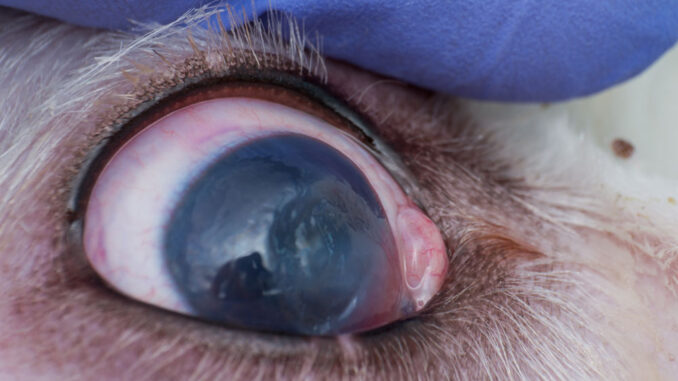
This article was updated on March 17th, 2023
A squinty, watery eye in our canine companions is a common, yet frightening, issue especially when it’s due to an ulcer. Anything out of the ordinary with a dog’s eye is cause for concern, but eye ulcers can be an even more serious problem, so veterinary care should be sought out immediately.
What is an Eye Ulcer in Dogs?
The cornea is the clear part of the eye. It helps to focus the entering light to the back of the eye so it is transmitted to the brain. The cornea is made up of four layers: the epithelium, stroma, Descemet’s membrane, and the endothelium.
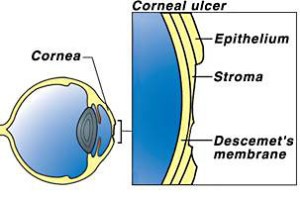
The outermost layer, the epithelium, serves to protect the eye from chemicals, microbes, water, and other things that you don’t want getting in there. Under that is the stroma which produces growth factors important for corneal development and repair. Descemet’s membrane is a gateway for nutrients to the stroma and adheres the innermost layer, the endothelium, to the rest of the cornea.
An ulcer is when an abrasion or hole gets made in one or more of the layers of the cornea. The severity of the ulcer depends on how many layers are affected. Superficial ulcers in the epithelium tend to be milder than ulcers making their way clear to the Descemet’s membrane.
What Does an Eye Ulcer in Dogs Look Like? [With Pictures]
A hole in a dog’s eye drums up a scary and painful image. Dogs with corneal ulcers of any level are going to have watery discharge, squinting, light sensitivity, and may paw or rub at the eye. Now, different types of ulcers may appear differently, so let’s dive in.
- Superficial ulcers: These only affect the epithelium of the cornea, and since it’s self-healing, most superficial, uncomplicated ulcers will heal within one week, two at the most. Superficial ulcers may first appear with a bluish tint as the cornea swells, and dogs should get less and less painful by the day.
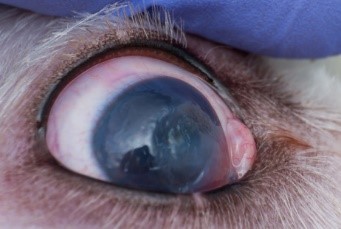
- Stromal ulcers: Stromal ulcers are more severe since they go completely through the epithelium and into the stromal layer. These will also start out with a bluish tint as the cornea swells and then a red spiderweb of blood vessels will start to cover the eye as it starts to heal. This is one that always looks worse before it gets better. Stromal ulcers take a couple of weeks or more to heal and are very painful.
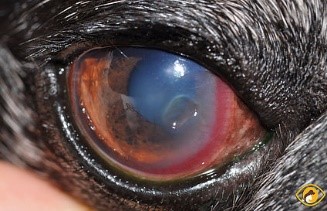
- Descemetoceles: An ulcer that extends to Descemet’s membrane is called a descemetocele. If the ulcer gets to the endothelium, it is considered a perforation, and fluid from the eyeball may start to leak out. These are very serious ulcers and need aggressive treatment to preserve vision and prevent prolapse of the eye. Descemetoceles are extremely painful and you can see a deep hole on the surface of the eye along with the bluish, then reddish tint.
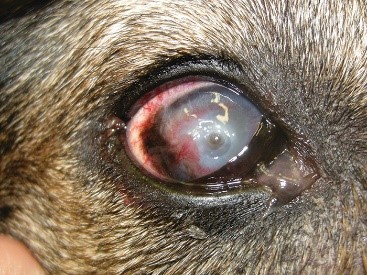
What Causes Eye Ulcers in Dogs?
Far and wide the most common cause of eye ulcers in dogs is trauma. Pokes from plants, scrapes from play, or scratches from an errant claw are all capable of causing an eye ulcer. Even rubbing a dog’s itchy, allergy eyes on the carpet can lead to an ulcer.
Eye ulcers are more common in brachycephalic breeds, or those with short noses, smushed faces, and protruding eyeballs. This is simply because eyeballs in these breeds stick out further with less protection than eyeballs of other breeds.
A less common cause of eye ulcers in dogs is dry eye, a condition known as keratoconjunctivitis sicca. This is when the tear glands don’t produce enough tears for moisturization causing the surface of the cornea to dry out. Cushing’s disease, diabetes, hypothyroidism, and abnormal eyelids or eyelashes can also make a dog’s eye more susceptible to corneal ulcers. Occasionally, a bacterial infection elsewhere in the eye can bring on a corneal ulcer as well.
At-Home Steps to Take When You Think Your Dog Has an Eye Ulcer
Since an eye ulcer is literally a hole in your dog’s eye, calling your vet should always be the first step, even if you’re not certain your dog has an eye ulcer. Consult your vet anytime your dog has watery discharge, eye redness, swelling, squinting, or pawing of their eye. While you figure out appointment times there are some steps you may take to help make your dog more comfortable.
- Flush your dog’s eye with sterile saline solution or a dog eye wash, such as Vetricyn Plus. This will help to clear any irritants, allergens, or loose foreign bodies that may be causing the problem.
- Apply a warm compress over the eye. Make sure it’s not too hot by testing it on the inside of your wrist. This may just provide a little relief.
- Call your veterinarian for any eye issues more severe than a little redness and discharge. If the eye is painful, causing the dog to squint or paw at their eye, get the next available appointment. If you suspect a deep ulcer or a descemetocele, seek emergency treatment.
How are Eye Ulcers Diagnosed?
Veterinarian’s will use fluorescein stain to diagnose an eye ulcer. This stain sticks to ulcerated area and makes it glow green. Small ulcers may require special lights to be seen. Deep ulcers may need to be sampled to check for microbes.
Vets may also check for proper tear production and other underlying illnesses if a dog has recurrent eye ulcer issues. Be ready to answer questions about how the ulcer happened and when. Your vet may also be interested in other signs to indicate underlying issues, such as appetite, energy level, and water consumption.
How Are Eye Ulcers in Dogs Treated?
Once a diagnosis of an eye ulcer is made, the treatment plan will depend on the severity.
- Superficial: Most superficial ulcers will heal within a week or two. Medicated eye drops or ointments to help prevent infections and reduce pain can be given until the ulcer is healed. If a dog is an aggressive eye rubber, you may also need an E-collar to keep them from causing further damage. Without any complications, a superficial ulcer may cost $100-$200.
- Deep: Any ulcer that gets through the stroma and into Descemet’s membrane will need a little extra care and protection. These aren’t going to heal within a week and may require medicated eyedrops for three weeks or longer. Severe deep ulcers may also require surgery where a graft or the eyelid is sewn closed over the eye to protect the ulcer and prevent prolapse. Dogs may also need anti-inflammatories or pain medications by mouth and wear an E-collar until healed. Deep ulcers are going to cost $300-$1,000 or more especially if it requires referral to a specialist.
Follow-up Care for Eye Ulcers
Eye ulcers aren’t fix-it-and-forget-it kind of issues. They will require care well after you leave the veterinarian’s office. Superficial ulcers will need eye drops every 4-6 hours until the eye is healed. You’ll want to make sure your dog can’t rub or scratch at their eye during this process. Your vet will want to recheck in about a week to make sure everything is going as planned. The blueness will start to slowly go away along with your dog’s pain and discomfort.
Deep ulcers are going to be more involved and require more time. Antibiotics, as well as anti-inflammatory drops, may be needed every few hours and oral medications may be added as well. Your dog will have an E-collar and need rechecks every week or so until healed.
Don’t expect a deep ulcer to heal in less than three weeks if all goes well. As a deep ulcer heals, it will look worse before it gets better. The eye will go from bluish to red and ugly as the blood vessels move in and start healing. Don’t hesitate to ask your veterinarian if everything looks ok at any stage along this process.
What is the Prognosis for a Dog with an Eye Ulcer?
Superficial eye ulcers typically have a good outcome, especially with proper treatment. It shouldn’t have any lasting impact on your dog’s vision. If ulcers become a recurrent issue, your vet should check for any underlying health concerns, such as diabetes, Cushing’s, or eye abnormalities, that could be causing them.
Deep ulcers need proper and immediate treatment to prevent them from getting worse to the point that they cause permanent damage to the eye. If caught early and treated properly, deep ulcers can heal completely with no lasting effects. If the ulcer is severe or not treated properly, there may be some scarring issues that impede vision permanently. If the eye prolapses or ruptures, it will more than likely need to be removed.
FAQ:
Can an eye ulcer heal on its own?
Superficial ulcers that aren’t infected may heal on their own without any treatment. However, even simple ulcers can take a turn for the worse if they aren’t treated properly. Consulting your veterinarian even if you don’t plan to do any treatment is always advised.
Related posts about dog eye issues:
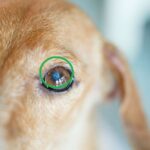
Disclaimer: This website's content is not a substitute for veterinary care. Always consult with your veterinarian for healthcare decisions. Read More.


Be the first to comment